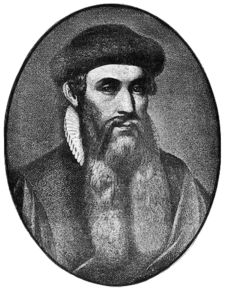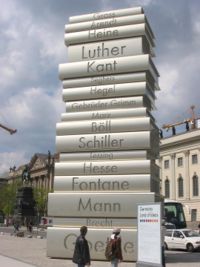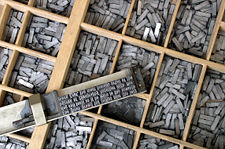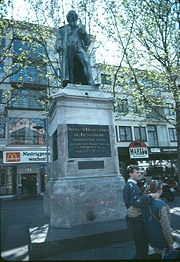Johannes Gutenberg
2008/9 Schools Wikipedia Selection. Related subjects: Engineers and inventors
| Johannes Gensfleisch zur Laden zum Gutenberg | |
 |
|
| Born | c. 1400 Mainz, Germany |
|---|---|
| Died | February 3, 1468 Mainz, Germany |
| Occupation | Engraver, Inventor, and Printer |
Johannes Gensfleisch zur Laden zum Gutenberg ( c. 1400 – February 3, 1468) was a German goldsmith and printer who is credited with inventing movable type printing in Europe around 1439 and mechanical printing globally. His major work, the Gutenberg Bible (also known as the 42-line Bible), has been acclaimed for its high aesthetic and technical quality.
Among the specific contributions to printing that are attributed to Gutenberg are the design of metal movable type, the invention of a process for making such type in quantity (mass production), the use of oil-based ink, and the use of a wooden printing press similar to the screw olive and wine presses of the period. His truly epochal invention was the combination of these elements into a practical system. Gutenberg may have been familiar with printing; it is claimed that he had worked on copper engravings with an artist known as the Master of the Playing Cards. Gutenberg's method for making type is traditionally considered to have included a type metal alloy and a hand mould for casting type. It should be noted that new research may indicate that standardised moveable type was a more complex evolutionary process spread over multiple locations.
The use of movable type was a marked improvement on the handwritten manuscript, which was the existing method of book production in Europe, and upon woodblock printing, and revolutionized European book-making. Gutenberg's printing technology spread rapidly throughout Europe and is considered a key factor in the European Renaissance. Gutenberg remains a towering figure in the popular image; in 1999, the A&E Network ranked Gutenberg #1 on their "People of the Millennium" countdown, and in 1997, Time–Life magazine picked Gutenberg's invention as the most important of the second millennium.
Life

Gutenberg was born in the German city of Mainz, the youngest son of the upper-class merchant Friele Gensfleisch zur Laden, and his second wife Else Wyrich, who was the daughter of a shopkeeper. According to some accounts Friele was a goldsmith for the bishop at Mainz, but most likely he was involved in the cloth trade. Gutenberg's year of birth is not known; it was certainly between 1394 and 1404, most likely around 1400.
At the time, patricians in Mainz were often named after the houses they owned, and around 1427, the name zu Gutenberg, after the family house in Mainz, is documented for the first time. This house had previously been known as "Judenberg," Jewish Hill. According to historian John Man, "In the 1282 pogrom, fifty-four Jewish properties were abandoned and were grabbed by the rich and powerful. It seems that the Gutenberg house fell to the archbishop's treasurers. It was later acquired by the great-great-grandfather of our inventor and stayed in the family."
In 1411, there was an uprising in Mainz against the patricians, and more than a hundred families were forced to leave. The Gutenbergs may have moved to Eltville am Rhein (Alta Villa), where his mother had an inherited estate. He may have studied at the University of Erfurt, where there is a record of a student in 1419 named Johannes de Alta villa. Following his father's death in 1419, he is mentioned in the inheritance proceedings.
Nothing is now known of Gutenberg's life for the next fifteen years, but in March 1434, a letter by him indicates that he was living in Strasbourg, where he had some relatives on his mother's side. He also appears to have been a goldsmith member enrolled in the Strasbourg militia. In 1437, there is evidence that he was instructing a wealthy tradesman on polishing gems, but where he had acquired this knowledge is unknown. In 1436/37 his name also comes up in court in connection with a broken promise of marriage to a woman from Strasbourg, Ennelin. Whether the marriage actually took place is not recorded.
Printing press
Around 1439, Gutenberg was involved in a financial misadventure making polished metal mirrors (which were believed to capture holy light from religious relics) for sale to pilgrims to Aachen: in 1439 the city was planning to exhibit its collection of relics from Emperor Charlemagne but the event was delayed by one year and the capital already spent could not be repaid. When the question of satisfying the investors came up, Gutenberg is said to have promised to share a "secret". It has been widely speculated that this secret may have been the idea of printing with movable type. Legend has it that the idea came to him "like a ray of light".
At least up to 1444, he lived in Strasbourg, most likely in the St. Arbogast suburb. It was in Strasbourg in 1440 that Gutenberg perfected and unveiled the secret of printing based on his research, mysteriously entitled Kunst und Aventur (art and enterprise). It is not clear what work he was engaged in, or whether some early trials with printing from movable type may have been conducted there. After this, there is a gap of four years in the record. In 1448, he was back in Mainz, where he took out a loan from his brother-in-law Arnold Gelthus, presumably for a printing press.
By 1450, the press was in operation, and a German poem had been printed, possibly the first item to be printed there. Gutenberg was able to convince the wealthy moneylender Johann Fust for a loan of 800 guilders. Peter Schöffer, who became Fust's son-in-law, also joined the enterprise. Schöffer had worked as a scribe in Paris and designed some of the first typefaces.
Gutenberg's workshop was set up at Hof Humbrecht, a property belonging to a distant relative. It is not clear when Gutenberg conceived the Bible project, but for this he borrowed another 800 guilders from Fust, and work commenced in 1452. At the same time, the press was also printing other, more lucrative texts (possibly Latin grammars). There is also some speculation that there may have been two presses, one for the pedestrian texts, and one for the Bible. One of the profit-making enterprises of the new press was the printing of thousands of indulgences for the church, documented from 1454–55.
In 1455 Gutenberg published his 42-line Bible, commonly known as the Gutenberg Bible. About 180 were printed, most on paper and some on vellum.
Court case
Sometime in 1455, there was a dispute between Gutenberg and Fust, and Fust demanded his money back, accusing Gutenberg of embezzling funds. Meanwhile the expenses of the Bible project had proliferated, and Gutenberg's debt now exceeded 2,000 guilders. Fust sued at the archbishop's court. A November 1455 legal document records that there was a partnership for a "project of the books," the funds for which Gutenberg had used for other purposes, according to Fust. The court decided in favour of Fust, giving him control over the Bible printing workshop and half of all printed Bibles.
Thus Gutenberg was effectively bankrupt, but it appears he retained (or re-started) a small printing shop, and participated in the printing of a bible in the town of Bamberg around 1459, for which he at least supplied the type. But since his printed books never carry his name or a date, it is difficult to be certain, and there is consequently a considerable scholarly literature about it. It is also possible that the large Catholicon dictionary, 300 copies of 744 pages, printed in Mainz in 1460, may have been executed in his workshop.
Meanwhile, the Fust–Schöffer shop were the first to bring out a book with the printer's name and date, the Mainz Psalter of August 1457, and while proudly proclaiming the mechanical process by which it had been produced, it made no mention of Gutenberg.
Later life
In 1462, during a conflict between two archbishops, Mainz was sacked by archbishop Adolph von Nassau, and Gutenberg was exiled. An old man by now, he moved to Eltville where he may have initiated and supervised a new printing press belonging to the brothers Bechtermünze.
In January 1465, Gutenberg's achievements were recognized and he was given the title Hofmann (gentleman of the court) by von Nassau. This honour included a stipend, an annual court outfit, as well as 2180 liters of grain and 2000 liters of wine tax-free. It is believed he may have moved back to Mainz around this time, but this is not certain.
Gutenberg died in 1468 and was buried in the Franciscan church at Mainz, his contributions largely unknown. This church and the cemetery were later destroyed, and Gutenberg's grave is lost.
In 1504, he was mentioned as the inventor of typography in a book by Professor Ivo Wittig. It was not until 1567 that the first portrait of Gutenberg, almost certainly an imaginary reconstruction, appeared in Heinrich Pantaleon's biography of famous Germans.
Printed books

Between 1450 and 1455, Gutenberg printed several texts, but details are not known; his texts did not bear the printer's name or date, so attribution is possible only through external references. Certainly several church documents including a papal letter and two indulgences were printed. Some printed editions of Ars Minor, a schoolbook on Latin grammar by Aelius Donatus may have been printed by Gutenberg; these have been dated either 1451–52 or 1455.
In 1455 (possibly starting 1454), Gutenberg brought out copies of a beautifully executed folio Bible (Biblia Sacra), with 42 lines on each page. The pages of the books were not bound, and the date 1455 is documented on the spine by the binder for a copy bound in Paris.
The Bible sold for 30 florins each, which was roughly three years' wages for an average clerk. Nonetheless, it was significantly cheaper than a handwritten Bible that could take a single scribe over a year to prepare. After printing the text portions, each book was hand illustrated in the same elegant way as manuscript Bibles from the same period written by scribes.
48 substantially complete copies are known to exist, including two at the British Library that can be viewed and compared online. The text lacks modern features such as pagination, indentations, and paragraph breaks.
Another, 36-line edition of the Bible was also printed, some years after the first edition, and in large part set from a copy of it, thus disproving earlier speculation that this may have been the first Bible of the two.
Printing method with movable type
Gutenberg's early printing process, and what tests he may have made with movable type, are not known in great detail. His later Bibles were printed six pages at a time, and would have required 100,000 pieces of type—making the type alone would take years. Setting each page would take at least half a day, and considering all the work in loading the press, inking the type, hanging up the sheets, etc., it is thought that the Gutenberg–Fust shop might have employed about 25 craftsmen.
Gutenberg's technique of making movable type remains unclear. In the following decades, punches and copper matrices became standardized in the rapidly disseminating printing presses across Europe. Whether Gutenberg used this sophisticated technique or a somewhat primitive version has been the subject of considerable debate.
In the standard process of making type, a hard metal punch (with the letter carved back to front) is hammered into the soft metal copper, creating a mould or matrix. This is then placed into a holder, and cast by filling with hot type-metal, which cooled down to create a piece of type. The matrix can now be reused to create hundreds of identical letters, so that the same type appearing anywhere in the book will appear similar, giving rise to the growth of fonts. Subsequently, these letters are placed on a rack and inked; using a press, many hundred copies can be made. The letters can be reused in any combination, earning the process the name of 'movable type'. (For details, see Typography).
Was the type produced by punches and copper matrices?
Such is the process that has been widely attributed to have been Gutenberg's invention, but it appears from recent evidence that Gutenberg's actual process was somewhat different. If he used the punch and matrix approach, all his letters should have been identical, within some variation possibly due to inking. However, the type used in Gutenberg's printed Bibles were quite irregular.
In 2001, the physicist Blaise Aguera y Arcas and Princeton librarian Paul Needham, used digital scans of the Gutenberg Bible in the Scheide Library, Princeton, to carefully compare the same letters (types) appearing in different parts of the Gutenberg 42-line Bible. The irregularities in Gutenberg's type, particularly in simple characters such as the hyphen, made it clear that the variations could not have come from either ink smear or from wear and damage on the pieces of metal on the types themselves. While some identical types are clearly used on other pages, other variations, subjected to detailed image analysis, made for only one conclusion: that they could not have been produced from the same matrix. Transmitted light pictures of the page also revealed substructures in the type that could not arise from punchcutting techniques. They hypothesized that the method involved impressing simple shapes to create alphabets in "cuneiform" style in a mould like sand. Casting the type would destroy the mould, and the alphabet would need to be recreated to make additional type. This would explain the non-identical type, as well as the substructures observed in the printed type.
Thus, they feel that "the decisive factor for the birth of typography", the use of reusable moulds for casting type, might have been a more progressive process than was previously thought. They suggest that the additional step of using the punch to create a mould that could be reused many times was not taken until twenty years later, in the 1470s.
Other hypotheses about European origins
The nineteenth century printer and typefounder Fournier Le Jeune suggested that Gutenberg might not have been using type cast with a reusable matrix, but possibly wooden types that were carved individually. However, this appears unlikely given the uniformity of the bulk of the type he used.
It has also been questioned whether Gutenberg used movable types at all. In 2004, Italian professor Bruno Fabbiani claimed that examination of the 42-line Bible revealed an overlapping of letters, suggesting that Gutenberg did not in fact use movable type (individual cast characters) but rather used whole plates made from a system somewhat like a modern typewriter, whereby the letters were stamped successively into the plate and then printed. However, most specialists regard the occasional overlapping of type as caused by paper movement over pieces of type of slightly unequal height.
A 1568 history by Hadrianus Junius of Holland claims that the basic idea of the movable type came to Gutenberg from Laurens Janszoon Coster via Fust, who was apprenticed to Coster in the 1430s and may have brought some of his equipment from Haarlem to Mainz. While Coster appears to have experimented with moulds and cast-able metal type, there is no evidence that he had actually printed anything with this technology. He was an inventor and a goldsmith. However, there is one support for the claim that Coster might be the inventor. In the Kölner Chronik of 1499 Ulrich Zell, the first printer of Cologne, mentions that printing was performed in Mainz of 1450, but that before already some type of printing of lower quality occurred in The Netherlands. The name of Coster is not however mentioned in that chronicle.
Hypotheses about East Asian origins
Since the use of printing from movable type arose in East Asia well before it did in Europe, it is relevant to ask whether Gutenberg may have been influenced, directly or indirectly, by the Chinese or Korean inventions of movable type printing, or their earlier discoveries of block printing.
There are no historical documents which single out that Gutenberg was aware of existing Asian printing techniques. Nonetheless, several historians have drawn inferences. The earliest woodblocks used for printing in Europe, in the fourteenth century, using exactly the same technique as Chinese woodblocks, led some early writers on Asian subjects to speculate about a connection: "the process of printing them must have been copied from ancient Chinese specimens, brought from that country by some early travelers, whose names have not been handed down to our times" ( Robert Curzon, 1810-1873). Since the 13th century, with the expansion of the Mongol Empire to the door of Europe, numerous travelers bridged the distance between Europe and China, such as Marco Polo or the Mongol Chinese Rabban Bar Sauma, and numerous direct contacts occurred in attempts at creating a Franco-Mongol alliance, giving ample opportunity for the transmission of printing technology from China.
However, European woodblock printing shows a clear progression from patterns to images, both printed on cloth, then to images printed on paper, when it became widely available in Europe in about 1400. In particular, text and images printed together only appear in about 1460, some sixty years later than images alone, and after Gutenberg's invention of metal movable type.
Joseph Needham's Science and Civilization in China has a chapter that suggests that "European block printers must not only have seen Chinese samples, but perhaps had been taught by missionaries or others who had learned these un-European methods from Chinese printers during their residence in China."
But historians of the Western prints themselves see no need for such a direct and late connection. Rather, they assume that European woodcut appeared "spontaneously and presumably as a result of the use of paper as it had been observed that paper was better suited than rough-surfaced parchment for making the impressions from wood-reliefs". Also, A. Hyatt Mayor states:
| {{{quote}}} —{{{source}}} |
Whatever the facts regarding Asian influences in this invention, there can be no doubt about Gutenberg's genius in putting together the technologies that eventually went on to fuel the European Renaissance.
Legacy
Although Gutenberg was financially unsuccessful in his lifetime, the printing technologies spread quickly, and news and books began to travel across Europe much faster than before. It fed the growing Renaissance, and since it greatly facilitated scientific publishing, it was a major catalyst for the later scientific revolution.
The capital of printing in Europe shifted to Venice, where visionary printers like Aldus Manutius ensured widespread availability of the major Greek and Latin texts. The claims of an Italian origin for movable type have also focused on this rapid rise of Italy in movable-type printing. This may perhaps be explained by the prior eminence of Italy in the paper and printing trade. Additionally, Italy's economy was growing rapidly at the time, facilitating the spread of literacy. Finally, the city of Mainz was sacked in 1462, driving many (including a number of printers and punch cutters) into exile.
Printing was also a factor in the Reformation: Martin Luther found that the 95 Theses, which he posted on the door of his church, were printed and circulated widely; subsequently he also issued broadsheets outlining his anti- indulgences position (ironically, indulgences were one of the first items Gutenberg had printed). The broadsheet evolved into newspapers and defined the mass media we know today.
In the decades after Gutenberg, many conservative patrons looked down on cheap printed books; books produced by hand were considered more desirable. At one point the papal court debated a policy of requiring printing presses to obtain a license, but this could not be decreed.
Today there is a large antique market for the earliest printed objects. Books printed prior to 1500 are known as incunabula.
There are many statues of Gutenberg in Germany, including the famous one by Bertel Thorvaldsen (1837) in Mainz, home to the Gutenberg Museum and the eponymous Johannes Gutenberg University of Mainz.
Project Gutenberg commemorates Gutenberg's name.
Matthew Skelton's book Endymion Spring explores a controversial theory about Johann Gutenberg and his partner Fust.
In 1961 the Canadian philosopher and scholar Marshall McLuhan entitled his pioneering study in the fields of print culture, cultural studies, and media ecology, The Gutenberg Galaxy: The Making of Typographic Man
Johann Gutenberg has been ranked #8 in Michael H. Hart's controversial book, The 100: A Ranking Of The Most Influential Persons In History.
In 2006, Gutenberg! The Musical!, a musical about two people who wrote a musical about Johann Gutenberg inventing the printing press, began its Off-Broadway run in New York City.

